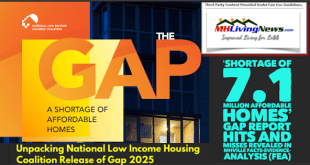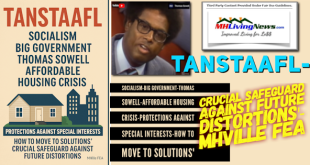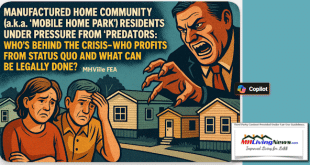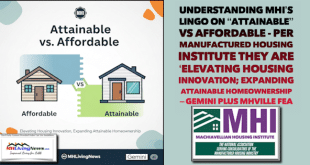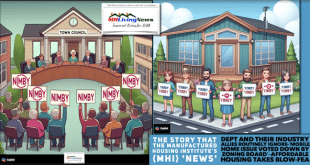- The federal government is seen by many as being even handed and objective. But others disagree, thinking that bureaucrats often have their own agenda, or are promoting a program created by/for others.
Whatever side of the controversial topic of the objectiveness and effectiveness of the federal government you’re on, what’s certain is that this report should be an eye-opener for all who care about quality affordable homes for millions who need them, and those who yearn for their piece of the American Dream.

HUD and the Housing Affordability Crisis
The Department of Housing and Urban Development (HUD) uses the following as their truly noble-sounding mission statement.
“HUD’s mission is to create strong, sustainable, inclusive communities and quality affordable homes for all.”

We will also glance at HUD’s Office of General Counsel (OGC) mission, because an ‘insider’ federal source has told MHLivingNews that “for decades,” a specific HUD attorney “deliberately ignored” and “failed to enforce” the law.
HUD OGC Mission Statement
“Our mission is to provide legal services, based on the highest professional and ethical standards, that support and facilitate the achievement of HUD’s mission of strengthening our nation’s communities, promoting affordable housing, dismantling the barriers to home ownership, expanding homeownership opportunities for all Americans, particularly low-and moderate income families, ending chronic homelessness and vigorously enforcing fair housing, civil rights and anti-discrimination laws…”
The HUD OGC’s commitment statement to that mission begins as follows.
Our Commitments
“To accomplish our mission and be recognized as a leader at HUD in providing high quality services and further contributing to the mission and success of HUD, our commitments are:
- To enforce HUD’s laws and regulations consistently, fairly and effectively…”
Against that backdrop, we’ll look at federally-commissioned, university level scholarship – known as a HUD Office of Policy Development and Research (PD&R) – study.
The academics who did this study focused on a controversial topic – the application of manufactured housing, which is regulated by HUD – as an affordable housing option, particularly in urban areas.
Defying Stereotypes, Myths, and Misconceptions
The open-minded person who relies on this federally-sanctioned HUD PD&R study – which is provided in full at the end of this article – will see that the researchers found that manufactured homes provided an intelligent solution, one that defied stereotypes.
Quality, durability, appreciation, impact on conventional housing values in that area, were all among the issues studied.
So this report isn’t ‘industry talk.’ Rather, what follows are among the insightful findings of university scholars, who had to document their findings and research.
One point that must be stressed is that the authors of this PD&R appear to be operating under at least one – and highly significant – false premise.

They don’t seem to understand the plain meaning of the Manufactured Housing Improvement Act of 2000, which gave HUD – as the federal regulator of the quality, safety and energy saving value of HUD Code manufactured homes – “enhanced preemption” over local zoning.
That HUD “enhanced preemption” over often NIMBY- or BANANA-minded local officials and others – when enforced – would open up the floodgates to millions of Americans who could afford a quality manufactured home at about half-the-cost of similar conventional construction.
This is an issue that the previously mentioned HUD OGC attorney allegedly insisted on not enforcing, though the law arguably gave HUD the obvious jurisdiction over their own program.
Indeed, how rare is it that a federal official argues that they ‘don’t have authority’ over a matter their agency is tasked with?
We’ll look at that vexing failure at HUD to enforce the law in a future article, because it deserves separate treatment.
HUD’s PDR isn’t Alone…
We’re posting videos below – including an interview with the prior administrator of the HUD Code manufactured housing program – that echo facts noted by the researchers of this PDR.
Note that like those academics, the videos include facts – such as the quality and appeal of the homes are akin to conventional housing – and at about half-the-price.
Who says? Listen to the voices and experts in those videos. which are similar to those found by the third party researchers, and the U.S. Census Bureau.
Lisa Tyler, Ph.D. on Manufactured Housing

“Manufactured housing presents a solution,” said Lisa Tyler, Ph.D., associate academic dean at Bethel University told MHLivingNews. “It’s inexpensive, energy efficient, and a great value. There’s a lot of opportunity for growth in the industry, but a lot of obstacles, too.”
The obstacles revolve around outdated myths, or unjustified stigma, says Tyler.
She should know, as Tyler is reportedly the first person in over a decade to complete a doctoral study on the subject of manufactured homes.
Affordable Housing Solution?
If These University and Other Researchers See Manufactured Homes as A Solution,
Why Is Its Proper Use Being Held Up?
We plan a new report in the near term. It will look at special interests and other causes behind the stonewalling of the obvious solution manufactured homes (MH) present, which are spotlighted – not only here on MHLivingNews – but also by organizations like:
- the Manufactured Housing Association for Regulatory Reform (MHARR),
- consumer advocacy groups – such as the Corporation for Enterprise Development (CFED),
- which, along with several mainstream media sites shown in the graphic below, have spotlighted the MH option in the past year.
While we’ve selected a number of specific quotes from the researchers’ study in Oakland, California, let’s note again that the entire study is available at the end of this report as a download.
We will use only limited commentary in what follows, and focus on what those scholars experts laser focused on, which should be key takeaways of interest to:
- home shoppers,
- housing officials in markets from coast-to-coast, that routinely say they don’t have enough funding and are thus struggling to meet low-cost housing demand,
- investors — because the private-money, free enterprise opportunities that exist for MH are in the tens of billions of dollars annually,
- current industry professionals and manufactured home owners, who deserve more respect and are arguably harmed by failure to enforce the law (the Manufactured Housing Improvement Act of 2000 or MHIA 2000),
- President Donald Trump, Vice-President Mike Pence, who’ve promised to “enforce the law,” create good jobs, and “drain the swamp” of Washington, D.C.
- HUD Secretary, Dr. Ben Carson, who has said he sees value to manufactured housing in rural areas, but may not be aware of studies such as this one, which demonstrates that manufactured homes could be used in many urban and suburban settings successfully too,
To tease the bottom-line? Manufactured housing offers a solution, yet it is one that the federal and local governments are inexplicably ignoring — or blocking.
Against that backdrop, let’s look at some quotes from HUD’s PD&R report – Regulatory Barriers to Manufactured Housing Placement in Urban Communities.

Federally Commissioned University Study
Contradicted
Common Concerns About Manufactured Homes in Urban Areas
Surprising Research Facts at a Glance:
- Manufactured homes appreciate at similar rates to nearby conventional housing.
- Manufactured homes don’t have a negative impact on nearby conventionally built housing’s value.
- Many of the stereotypical myths about manufactured homes – such as they are moved often, or that they can’t fit in with the look of a local neighborhood – are incorrect.
At any given time, studies commissioned by the federal government are underway, by the hundreds and thousands. So, it’s no surprise when a potentially important university study, such as the one we’ll be quoting from extensively in this article, goes largely unnoticed.

Quoting from the PD&R, Cited Above
“Evidence suggests that residents of manufactured homes view their homes to be of a quality that is comparable to site-built homes. Boehm (1995) finds that residents of manufactured homes perceive their homes to be of higher quality than similar rental units and of lower cost than traditional owned units. This quality-cost advantage points to a potentially significant market demand for manufactured units if regulatory barriers are reduced.”
“With the increased use of multi-section units and recent innovations in manufactured housing building technology, particularly integrated floor and chassis systems, many manufactured housing units are now virtually indistinguishable from conventional site-built units.”
“Perhaps the most significant barrier to the siting of new manufactured homes in metropolitan areas is the presence of zoning codes which restrict the size, design, and location of manufactured units.”

- General prejudice against all forms of low-cost housing (Beamish et al. 2001).
- The perception that manufactured home residents constitute a transient population with weak ties to the community (Atiles 1995; Beamish et al. 2001).
- The low aesthetic appeal of the traditional trailer park (sic) community design (Gann 2001).
- Perceptions that manufactured housing is substandard and unsafe (Advisory Commission on Regulatory Barriers to Affordable Housing 1991).
- The perception that manufactured housing appreciates more slowly than traditional sitebuilt homes and negatively influences adjacent housing prices.
Evidence suggests that nearly all of these claims are unwarranted and not based on empirical reality.”
The statement above deserves to be underscored, and carried by other academics and media in housing starved markets, from coast-to-coast.
Myths Aren’t Justified by Facts – More Quotes from HUD’s PD&R
“For example, despite the common perception that manufactured homes are moved on a more regular basis, the reality is that few manufactured homes are ever moved from their initial setup sites. Bean (2004) estimated that less than 5% of units are moved. American Housing Survey data from 1999 to 2003, reported later in Table 1.1., indicate that 7% of units were moved during this period.”
“Other evidence from the American Housing Survey suggests that the incidence of severe structural problems is no more frequent among manufactured housing residents than it is among all owner-occupants.”

“Regarding differences in home price appreciation, manufactured homes sited on owned lots exhibit appreciation rates that are comparable to those of site-built homes (Consumers Union 2003).”
“Furthermore, several studies find no evidence of any impact of manufactured homes on the sale prices of adjacent properties (Apgar et al. 2002; Warner and Scheuer 1993; Stephenson and Shen 1997; Hegji and Mitchell 2000). Despite this evidence, community residents continue to harbor stereotypes against manufactured housing and will likely continue to appeal to local government officials to impose regulatory restrictions on such housing.”
“Although demonstration programs (such as the Next-Gen and the Urban Design projects) generally report positive results, research to date has not addressed whether these design improvements have resulted in greater acceptance of manufactured housing in urban communities.”
Let’s jump back to our own narrative.
While we are thrilled to bring such research to the attention of potentially millions of people, we don’t need a university-level study to demonstrate that the misunderstandings about manufactured homes persist at high levels.
There are several factors that cause this to be true, among them, in no particular order of importance:
- Widespread failure by public officials, and the media that report on them, to use proper terminology, as if the words ‘trailer house,’ ‘mobile home,’ and ‘manufactured home’ were all describing the same thing. They’re not. There are legal, value and construction differences between each of those housing types. But would you know that from reading, hearing or watching the news? While some do get it right, sadly, most don’t.
- There is a legal and structural differences between the ‘trailer houses’ of 50+ years ago, the ‘mobile homes’ of 40+ years ago and the manufactured homes which began with the start of the first HUD Code home on June 15, 1976 and thereafter. Consider this surprising fact, there’s been no mobile homes built in the U.S. for over 40 years.
- Prior to Dr. Carson becoming the agency’s secretary, the apparent failures of leadership at HUD to state the facts and enforce the law has been part of the problem. But frankly another key element of the challenges with HUD Code manufactured housing lies with sources within the manufactured housing industry. That occurs every time opportunities are missed to properly promote, educate, and protect the enhanced preemption and practical solutions that manufactured homes should enjoy by law.
Summary

Let’s recap.
- Lisa Tyler,
- former HUD program director and attorney, Bill Matchneer,
- other professionals and home owners noted in the videos posted on this page,
- consumer groups, such as CFED,
- the Manufactured Housing Association for Regulatory Reform, and other industry professionals,
- millions of manufactured home owners – which recent HUD data, and third party research – all strongly suggest are happy with their homes,
- and the PDR researchers who are credited in this report,
have all come to very similar conclusions on this following point.
Modern manufactured homes offer an important solution to millions of Americans who want a good, quality place to live. These are homes that today are energy saving, and can build equity for their home-buyers.
The stigma’s and stereotypes are routinely proven to be misplaced.
MHLivingNews has interviewed several “frugal millionaires” – and cited the examples of celebrities and upper middle class and millionaires – who have decided that a manufactured home makes great sense.
So why is there so much stigma? Why are offensive tweets like Keith Olbermann’s tolerated?
Why is there such a hesitancy – or hidden agenda? – at HUD to enforce the MHIA 2000 law?
The Multi-Billion Dollar Bombshell?
The bombshell is that HUD manages the manufactured housing program. Their own legal counsel has long taken a position that harms would be consumers of manufactured homes. Billions are wasted by HUD in the process.
If HUD followed the law, and applied the enhanced preemption the MHIA 2000 law calls for, much of the affordable housing crisis could be eased in a rather rapid – and free market – fashion.
That was the intent of the HUD Code in the first place. The ‘swamp’ of Washington D.C. has kept that solution in margins.
Dr. Carson has stressed his interest in private/public partnerships. While that’s commendable, far better from the federal, state or local budget’s vantage point would be solutions that were entirely generated by the private sector. That’s what MHARR’s president, CFED and others say that HUD Code manufactured homes could do.
Based on details we will cover in an upcoming report, we estimate that “unshackling” the industry – as MHARR President and CEO Mark Weiss, JD has termed it – would potentially create 1.5 million jobs in 3 to 5 years – while building an equal number of quality, affordable homes.
Tens of thousands of those homes being sold would result in reducing taxpayer costs, and would increase values in the neighborhoods they would be permanently sited in. It’s a proverbial win-win, though it isn’t perceived that way. This is why this research deserves another good look.

Understanding that there is nothing to fear, and enforcing existing laws are the keys.
Flashback and Flashforward

These issues raised by the questions above are among those we will dive into in upcoming reports. We will do that along with the lifestyle news and interviews that readers and viewers of MHLivingNews have come to enjoy.
Takeaways
If you own a manufactured home, stand tall!
If you are thinking about a home, why not check them out yourself?
If you are mainstream media, investors or other researchers seeking answers and opportunities – you’ve come to the right place with our trade media site for part of your research. We know of no one who’s interviewed and spotlighted more experts, home owners and professionals. Plus we have our own decades of experience in the industry, and in living in manufactured homes, having also lived in conventional housing.
We have some truly hot, and even more eye-opening reports coming soon. Please do yourself and others a favor. Don’t miss them, and do share them. ##
To download the HUD PD&R report referenced above – Regulatory Barriers to Manufactured Housing Placement in Urban Communities – click here.
(Image credits are as shown above, and from third parties, are provided under fair use guidelines.)

 manufacturedhomelivingnews.com Manufactured Home Living News
manufacturedhomelivingnews.com Manufactured Home Living News




